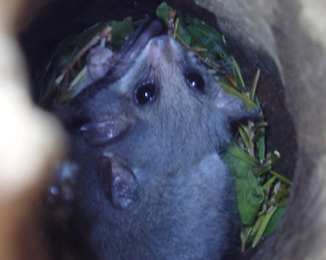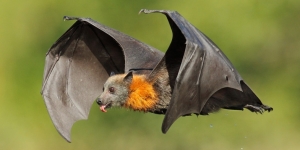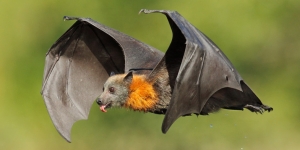Displaying items by tag: bats
Biodiversity in Ku-ring-gai
Over 700 native plant species and 300 vertebrate species have been recorded in Ku-ring-gai. On 19 June Chelsea Hankin (council’s Natural Areas Officer) gave an overview of council’s fauna monitoring program, including the latest results of their three long-term monitoring programs. She made the following points.
 Grey-headed Flying-fox
Grey-headed Flying-fox
The Ku-ring-gai Flying-fox Reserve (KFFR) in Gordon has been home to flying-foxes since the 1960s with reports of occupation in the 1940s.
Every third Thursday in the month (in collaboration with Ku-ring-gai Bat Conservation Society and regular volunteers) council conduct fly-out counts at strategic locations surrounding the KFFR.
Monthly counts provide long term data and ties in with the national census.
Numbers flying-foxes have fluctuated, though a downward trend is clear.
KFFR is important during extreme heat when temperatures climb to over 40°C because it has good structural complexity of vegetation layers (canopy, mid- and understorey) so flying-foxes are able to move down into the lower cooler layers of vegetation.
 Eastern Pygmy Possum
Eastern Pygmy Possum
The Eastern Pygmy Possum monitoring program has been running for more than three years in collaboration with volunteers.
28 nest boxes have been installed.
Eastern Pygmy Possums have not been identified on the western Lane Cove NP side of the LGA. We’ve had continued presence of EPP in areas with connectivity to either Ku-ring-gai Chase NP or Garigal NP, with evidence of successful breeding.
Eastern Pygmy-possum have been observed foraging on a range of flora species, including Banksia ericifolia, B. spinulosa, B. serrata, Lambertia formosa, Angophora hispida and Callistemon citrinus.
Cameras have detected plenty of other wildlife: Swamp Wallabies, Feathertail Glider, Brushtail Possum, Antechinus and Sugar Glider.
Microbats
Council began monitoring microbats at Pool to Pond (WildThings program) sites and creek lines in 2017. In 2018 the program was expanded to include natural bushland areas, wetlands, golf course dams and backyards without water features (a total of 64 sites).
Thirteen species have been detected, half of which are threatened.
The three most common species have been Eastern Freetail Bat, Eastern Bentwing-bat (threatened) and Gould’s Wattled Bat (a generalist species and highly adaptable to the urban landscape – sometimes seen taking advantage of insect concentrations around lights).
The specialist fishing bat Southern Myotis (threatened) has only been detected at larger bodies of water like dams, creeks and sediment ponds/wetlands. Southern Myotis require open stretches of water without clutter (aquatic vegetation or algae on surface) so they can ‘trawl’ using their large feet to catch small fish and aquatic invertebrates.
Three new records have confirmed the presence of Chalinolobus dwyeri, a species which until now had only been recorded once in 1992.
Freshwater Crayfish
Targeted surveys of freshwater crayfish in the last year have shown that two native species are co-existing, Euastacus australasiensis and E. spinifex.
Report Sightings
Contribute to council’s biodiversity database by report interesting fauna sightings to This email address is being protected from spambots. You need JavaScript enabled to view it..
Useful Apps
FrogID https://www.frogid.net.au
OzAtlas https://www.ala.org.au/who-we-are/downloadable-tools/ala-mobile-app/ contribute directly to the Atlas of Living Australia database
Hard Times for Flying-foxes in Sydney
Out thanks to the Ku-ring-gai Bat Conservation Society for permission to publish this article that was originally published in Friends of Bats newsletter in December 2015. It is written by Tim Pearson, a wildlife ecologist who is researching flying-fox communication for his PhD at Macquarie University.


